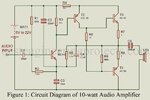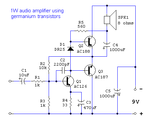dreamlover
Member level 2

While searching on internet for 10W audio amplifier, i found a circuit using 4 transistor shown bellow.
Now my question are
1. Is the value of coupling capacitor (c1) is appropriate for working with audio input signal?
2. If the value is enough to couple then how to calculate the value of capacitor (c1).
Note: According to my calculation the range of capacitor could be of few microfarad, but according the the given value in circuit diagram the it only passes signal above few KHZ frequency.

Now my question are
1. Is the value of coupling capacitor (c1) is appropriate for working with audio input signal?
2. If the value is enough to couple then how to calculate the value of capacitor (c1).
Note: According to my calculation the range of capacitor could be of few microfarad, but according the the given value in circuit diagram the it only passes signal above few KHZ frequency.









